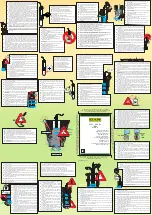
4
Parts & Service: 020 8988 7400 / E-mail: [email protected] or [email protected]
TOXIC FUME PREVENTION
Severe discomfort, illness or death can result from fumes, vapours, heat, or
oxygen enrichment or depletion that welding (or cutting) may produce.
Prevent them with adequate ventilation. NEVER ventilate with oxygen. Lead-,
cadmium-, zinc-, mercury- and beryllium-, bearing materials, when welded (or
cut) may produce harmful concentrations of toxic fumes. Adequate local
exhaust ventilation must be used, or each person in the area as well as the
operator must wear an air- supplied respirator. For beryllium, both must be
used. Metals coated with or containing materials that emit toxic fumes should
not be heated unless coating is removed from the work surface, the area is
well ventilated, or the operator wears an air-supplied respirator. Work in a
confined space only while it is being force ventilated and, if necessary, while
wearing an air-supplied respirator. Vapours from chlorinated solvents can be
decomposed by the heat of the arc (or flame) to form PHOSGENE, a highly
toxic gas, and other lung and eye irritating by-products. The ultraviolet
(radiant) energy of the arc can also decompose trichloroethylene and
perchloroethylene vapours to form phosgene. DO NOT WELD where solvent
vapours can be drawn into the welding atmosphere or where the radiant
energy can penetrate to atmospheres containing even minute amounts of
trichloroethylene or perchloroethylene.
FIRE AND EXPLOSION PREVENTION
Causes of fire and explosion are:
1. Combustibles reached by the arc, flying sparks, hot slag or heated
material;
2. Short circuits.
BE AWARE that flying sparks or falling slag can pass through cracks, along
pipes, through windows or doors, and through wall or floor openings, out of
sight of the goggled operator.
To prevent fires and explosion: keep equipment clean and operable, free of
oil, grease, and (in electrical parts) of metallic particles that can cause short
circuits. If combustibles are in the area,
DO NOT
weld. Move the work if
practicable, to an area free of combustibles.
Avoid working in paint spray rooms, dip tanks, storage areas, ventilators. If the
work cannot be moved, move combustibles away from sparks and heat; or
protect against ignition with suitable fire- resistant covers or shields.
Walls, ceilings, and floor near work should be protected by heat resistant
covers or shields. Fire watcher must be standing by with suitable fire
extinguishing equipment during and for some time after welding or cutting if:
1. Appreciable combustibles (including building construction) are within 10m.
2. Appreciable combustibles are further than 10m, but can be ignited by
sparks.
Summary of Contents for 6012100
Page 32: ......





































